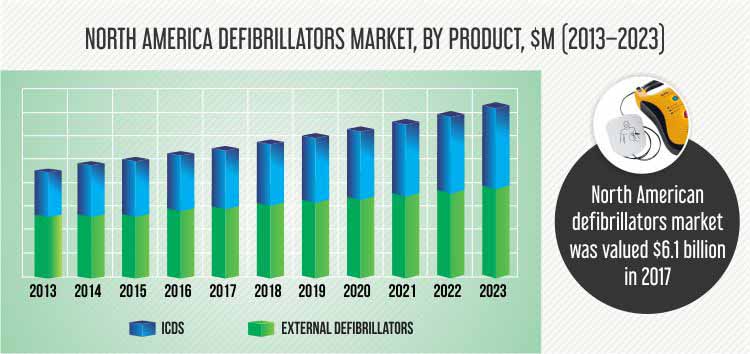Report Code: 11595 | Available Format: PDF | Pages: 134
North America Defibrillators Market by Product (ICDs [T-ICDs {CRT-Ds, Single-Chamber Defibrillators, Dual-Chamber Defibrillators}, S-ICDs], External Defibrillators [AEDs {Semi-Automated, Fully Automated}, Manual Defibrillators, Wearable Cardioverter Defibrillators]), by End User (Hospitals, Clinics, & Cardiac Centers, Pre-Hospital Care Settings, Public Access Settings, Home Care Settings), by Geography (U.S., Canada) - Market Size, Share, Development, Growth, and Demand Forecast, 2013-2023
- Report Code: 11595
- Available Format: PDF
- Pages: 134
- Report Description
- Table of Contents
- Market Segmentation
- Request Free Sample
North America Defibrillators Market Overview
The North American defibrillators market was valued $6.1 billion in 2017 and is projected to register a CAGR of 4.9% during 2018–2023, on account of factors, such as advancements in the defibrillation technology, surging aging population, rising incidence of cardiac diseases, and growing demand for automated external defibrillators (AEDs) in the region.

On the basis of product, the North American defibrillators market is categorized into implantable cardioverter defibrillators (ICDs) and external defibrillators. In 2017, ICDs held the larger share, of 55.4%, in this market. However, external defibrillator is predicted to be the faster growing category in the North American market, owing to the rising product awareness and growing public access to AEDs.
ICDs are further sub-segmented into transvenous implantable cardioverter defibrillators (T-ICDs) and subcutaneous implantable cardioverter defibrillators (S-ICDs). Of these, T-ICDs held the larger share, in terms of both value and volume, in the North American ICD market in 2017, with more than 1,25,000 T-ICDs sold in 2017. It is also predicted to be the faster growing category in the North American market, primarily due to the growing demand for cardiac resynchronization therapy defibrillators (CRT-Ds) and high adoption of ICDs among healthcare providers in the region.
The external defibrillators category is further classified into automated, manual defibrillators, and wearable cardioverter defibrillators. The automated defibrillators are expected to generate more than $2.5 billion revenue by 2023, mainly on account of increasing adoption of these products in the public access and home settings.
Based on end user, the North American defibrillators market is categorized into hospitals, clinics, and cardiac centers; public access settings; pre-hospital care settings; and home care settings. In 2017, hospitals, clinics, and cardiac centers as an end-user category contributed largest revenue, of $3.2 billion in this market. However, public access settings as an end-user category is expected to witness fastest growth, at a CAGR of 5.5% during the forecast period. This can be ascribed to the growing demand of AEDs in this end-user category.
The U.S. is expected to lead the North American defibrillators market. Increasing incidence of sudden cardiac arrests (SCAs), rising adoption of AEDs in schools and hospitality settings, presence of a large number of market players, and initiatives by the government to create awareness and provide training on defibrillation are the major factors driving the growth of the U.S. market.
North America Defibrillators Market Dynamics
Driver
Advancements in the defibrillation technology, surging geriatric population, rising incidence of cardiac diseases, and growing demand for AEDs are some of the factors driving the growth of the North American defibrillators market. Several advancements have been reported in the defibrillation technology over the past few decades. For example, S-ICD has significantly reduced the risks associated with conventional ICDs. Less complications associated with S-ICDs have led to the increased adoption of these devices.
The U.S. has the fastest-growing geriatric population globally. According to the 2018 Population Reference Bureau report, the total number of Americans aged 65 and older is anticipated to increase two-fold, from 46 million in 2014 to over 98 million by 2060. With the increase in age, elderly people tend to become susceptible to chronic diseases, majorly cardiovascular disorders (CVDs). Thus, with the growing number of elderly people, the demand for defibrillators is increasing in the North American region.
North America Defibrillators Market – Competitive Landscape
The players in the North American defibrillators market are continuously expanding their offerings to increase their market share. For example, in July 2017, BIOTRONIK SE & Co. KG obtained the USFDA approval for Intica DX and Intica CRT-D systems. Intica DX eliminates the need for atrial leads and provides the physician with critical diagnostic information based on a true atrial signal.
The North American defibrillators market is dominated by few major players including Koninklijke Philips N.V., Abbott Laboratories, Boston Scientific Corporation, Stryker Corporation, Medtronic plc, BIOTRONIK SE & Co. KG, SCHILLER AG, Asahi Kasei Corporation, Defibtech LLC, and Cardiac Science Corporation.
Want a report tailored exactly to your business strategy?
Request CustomizationWant an insight-rich discussion with the report author?
Speak to AnalystOur dedication to providing the most-accurate market information has earned us verification by Dun & Bradstreet (D&B). We strive for quality checking of the highest level to enable data-driven decision making for you
Our insights into the minutest levels of the markets, including the latest trends and competitive landscape, give you all the answers you need to take your business to new heights
With 24/7 research support, we ensure that the wheels of your business never stop turning. Don’t let time stand in your way. Get all your queries answered with a simple phone call or email, as and when required
We take a cautious approach to protecting your personal and confidential information. Trust is the strongest bond that connects us and our clients, and trust we build by complying with all international and domestic data protection and privacy laws